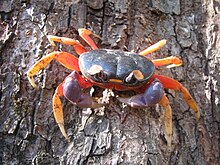Evolution
Gecarcinus quadratus, a land crab from Central and South America
Crabs are generally covered with a thick exoskeleton, and armed with a single pair of chelae (claws). Crabs are found in all of the world's oceans, while many crabs live in fresh water and on land, particularly in tropical regions. Crabs vary in size from the pea crab, a few millimetres wide, to the Japanese spider crab, with a leg span of up to 4 metres (13 ft).[4]
About 850 species of crab are freshwater, terrestrial or semi-terrestrial species;[5] they are found throughout the world's tropical and semi-tropical regions. They were previously thought to be a monophyletic group, but are now believed to represent at least two distinct lineages, one in the Old World and one in the New World.[6]
The earliest unambiguous crab fossils date from the Jurassic,[7] although Carboniferous Imocaris, known only from its carapace, may be a primitive crab.[8] The radiation of crabs in the Cretaceous and afterward may be linked either to the break-up of Gondwana or to the concurrent radiation of bony fish, crabs' main predators.[9]
Sexual dimorphism
The underside of a male (top) and a female (bottom) individual of Pachygrapsus marmoratus, showing the difference in shape of the abdomen
Crabs often show marked sexual dimorphism. Males often have larger claws,[10] a tendency which is particularly pronounced in the fiddler crabs of the genus Uca (Ocypodidae). In fiddler crabs, males have one claw which is greatly enlarged and which is used for communication, particularly for attracting a mate.[11] Another conspicuous difference is the form of the pleon (abdomen); in most male crabs, this is narrow and triangular in form, while females have a broader, rounded abdomen.[12] This is due to the fact that female crabs brood fertilised eggs on their pleopods





ساحة النقاش